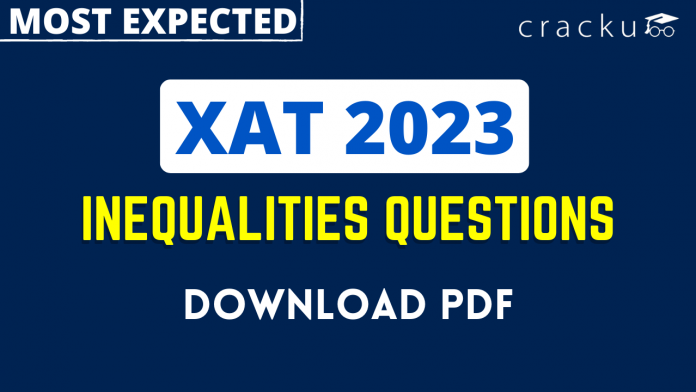XAT Inequalities Questions [Download PDF]
Download Inequalities Questions for XAT PDF – XAT Inequalities questions PDF by Cracku. Practice XAT solved Inequalities Questions paper tests, and these are the practice question to have a firm grasp on the Inequalities topic in the XAT exam. Top 20 very Important Inequalities Questions for XAT based on asked questions in previous exam papers. The XAT question papers contain actual questions asked with answers and solutions.
Download Inequalities Questions for XAT
Enroll to XAT 2023 Mocks & Sectionals
Instructions
Read the following informations and answer the given questions.
1.‘P$Q’ means ‘P is either greater than or equal to Q’
2.‘P@Q’ means ‘P is neither equal to nor smaller than Q’
3.‘P© Q’ means ‘P is neither smaller than nor greater than Q’
4.‘P£Q means P is not greater than Q
5.‘P?Q’ means ‘P is neither greater than nor equal Q
Question 1: N?S,S@P ,P£M.
Conclusion : I. S@M, II. P©N
a) If only one conclusion I follow
b) If only one conclusion II follow
c) If either conclusion I or II follow
d) If neither conclusion I or nor II follow
e) If both conclusions follow
1) Answer (D)
Solution:
Statements : N < S ; S > P ; P $\leq$ M
Conclusion :
I. S@M : $S>M$ : false
II. P©N : $P=N$ : false
Thus, neither conclusion I or nor II follow.
=> Ans – (D)
Question 2: J©P, P$N ,J£H
Conclusion : I. J©N, II. H@P
a) If only one conclusion I follow
b) If only one conclusion II follow
c) If either conclusion I or II follow
d) If neither conclusion I or nor II follow
e) If both conclusions follow
2) Answer (D)
Solution:
Statements : J = P ; P $\geq$ N ; J $\leq$ H
Combining above statements, we get : $H\geq J=P\geq N$
Conclusion :
I. J©N : $J=N$ : false
II. H@P : $H>P$ : false
Thus, neither conclusion I or nor II follow.
=> Ans – (D)
Question 3: Z@D,F© D,F$G
Conclusion : I. D©G, II. Z@G
a) If only one conclusion I follow
b) If only one conclusion II follow
c) If either conclusion I or II follow
d) If neither conclusion I or nor II follow
e) If both conclusions follow
3) Answer (B)
Solution:
Statements : Z > D ; F = D ; F $\geq$ G
Combining above statements, we get : $Z>D=F\geq G$
Conclusion :
I. D©G : $D=G$ : false
II. Z@G : $Z>G$ : true
Thus, only one conclusion II follow.
=> Ans – (B)
Question 4: L@T,P?T,K$L
Conclusion : I. L@P, II. K@T
a) If only one conclusion I follow
b) If only one conclusion II follow
c) If either conclusion I or II follow
d) If neither conclusion I or nor II follow
e) If both conclusions follow
4) Answer (E)
Solution:
Statements : L > T ; P < T ; K $\geq$ L
Combining above statements, we get : $K\geq L>T>P$
Conclusion :
I. L@P : $L>P$ : true
II. K@T : $K>T$ : true
Thus, both conclusions follow.
=> Ans – (E)
Question 5: R©U,U?Q,W$R
Conclusion : I. W©U, II. W@U
a) If only one conclusion I follow
b) If only one conclusion II follow
c) If either conclusion I or II follow
d) If neither conclusion I or nor II follow
e) If both conclusions follow
5) Answer (C)
Solution:
Statements : R = U ; U < Q ; W $\geq$ R
Combining above statements, we get : $Q>U=R$ and $W\geq R=U$
Conclusion :
I. W©U : $W=U$ : may be true
II. W@U : $W>U$ : may be true
Thus, either conclusion I or II follow.
=> Ans – (C)
Instructions
These questions are based on the following information:
‘A @B’ means A is added to B
‘A★B’ MEANs A is multiplied by B
‘A#B’ means A is divide by B
‘A$B’ means B Is subtracted from A
Question 6: Marks by sujit in History (H) are 85% of this marks obtained in science(M).
a) H= (100#85)★M
b) H=85★100★M
c) H=85#100#M
d) H=(85#100)★M
e) None of these
6) Answer (D)
Solution:
H = 85% of M
=> $H = \frac{85}{100} \times M$
$\therefore$ H = (85 # 100) ★ M
=> Ans – (D)
Question 7: salary of Mr X (S1) is more than 40% of Mr .Y’s salary(S2) BY Rs 8000.
a) S1=[S2★(40@100)]#8000
b) S1=[S2★(40#100)]@8000
c) S2=[S1★(40#100)]@8000
d) S2=[S1★(40@100)]#8000
e) None of these
7) Answer (B)
Solution:
S1 = 40% of S2 + 8000
=> $S1 = (\frac{40}{100} \times S2) + 8000$
=> $S1 = (S2 \times 40 \div 100) + 8000$
$\therefore$ S1 = [S2 ★ (40 # 100)] @ 8000
=> Ans – (B)
Question 8: Number of boys in (B) IN class is equal to one fourth of three times the number of girls (G) in the class
a) B=(3#G)★4
b) B=(3★G)@4
c) B=(3★G)#4
d) B=(3$G)#4
e) None of these
8) Answer (C)
Solution:
B = $\frac{1}{4} \times 3 \times$ G
=> $B = (3 \times G) \div 4$
$\therefore$ B = (3 ★ G) # 4
=> Ans – (C)
Question 9: Population of state M(P1) is less than half of population of state of N(P2) by 1,50,000
a) P2=(P1#2)$1,50,000
b) P1=(P2#2)@1,50,000
c) P1=(P2#2)$1,50,000
d) P2=(P2#2)$1,50,000
e) None of these
9) Answer (C)
Solution:
P1 = half of P2 – 1,50,000
=> P1 = $\frac{P2}{2}$ – 1,50,000
$\therefore$ P1 = (P2 # 2) $ 1,50,000
=> Ans – (C)
Question 10: Total age of 12 boys is X and the total age of the 13 girls is Y. What is the average age (A) of all the boys and girls together?
a) A=(X@Y)#25
b) A=(X$Y)#25
c) A=(X@Y)★25
d) Cannot be determined
e) None of these
10) Answer (A)
Solution:
A = total age/total students
=> A = (X + Y) $\div$ (12 + 13)
=> A = (X + Y) $\div$ 25
$\therefore$ A = (X @ Y) # 25
=> Ans – (A)
Instructions
In the following questions, the symbols @, #, %, $, * are used with different meanings as follows :
‘A @ B’ means ‘A is not smaller than B’.
‘A # B’ means ‘A is not greater than B’.
‘A % B’ means ‘A is neither greater than nor smaller than B’.
‘A $ B” means ‘A is neither greater than nor equal to B’.
‘A ©B’ means ‘A is neither smaller than nor equal to B’.
In each of the following questions assuming the given statements to be true, find out which of the three conclusions I, II and III given below them is/are definitely true.
Question 11: Statements: J#R,R©D ,D@F
Conclusions: I: F$R
II. F% R
a) If only one conclusion I follow
b) If only one conclusion II follow
c) If either conclusion I or II follow
d) If neither conclusion I or nor II follow
e) If both conclusions follow
11) Answer (A)
Solution:
Statements: J#R -> J $\leq$ R
R©D -> R > D
D@F -> D $\geq$ F
Combining above statements, we get : $R > D \geq F$
Conclusions: I: F$R -> F < R (TRUE)
II. F% R -> F = R (FALSE)
Thus, only conclusion I follows.
Question 12: Statements: L@K,K©A ,A$W
Conclusions: I: W$L
II. L# W
a) If only one conclusion I follow
b) If only one conclusion II follow
c) If either conclusion I or II follow
d) If neither conclusion I or nor II follow
e) If both conclusions follow
12) Answer (D)
Solution:
Statements : L $\geq$ K , K > A , A < W
After combining them : L $\geq$ K > A < W
Conclusion I : W < L (FALSE)
II : L $\leq$ W (FALSE)
Thus, none of the conclusion follows.
Question 13: Statements: N@J,J%R ,R©H
Conclusions: I: R # N
II. N©H
a) If only one conclusion I follow
b) If only one conclusion II follow
c) If either conclusion I or II follow
d) If neither conclusion I or nor II follow
e) If both conclusions follow
13) Answer (E)
Solution:
Statements : N $\geq$ J , J = R , R > H
After combining them : N $\geq$ J = R > H
Conclusion I : R $\leq$ N (True)
II : N > H (True)
Thus, both conclusion follows.
Question 14: Statements: H©M, M@E ,E$C
Conclusions: I: C©M
II. H©E
a) If only one conclusion I follow
b) If only one conclusion II follow
c) If either conclusion I or II follow
d) If neither conclusion I or nor II follow
e) If both conclusions follow
14) Answer (B)
Solution:
Statements : H > M , M $\geq$ E , E < C
After combining them : H > M $\geq$ E < C
Conclusion I : C > M (False)
II : H > E (True)
Thus, only conclusion II follows.
Question 15: Statements: V$W,W@T ,T#H
Conclusions: I. V©T
II. H%W
a) If only one conclusion I follow
b) If only one conclusion II follow
c) If either conclusion I or II follow
d) If neither conclusion I or nor II follow
e) If both conclusions follow
15) Answer (D)
Solution:
Statements : V < W , W $\geq$ T , T $\leq$ H
After combining them : V < W $\geq$ T $\leq$ H
Conclusion I : V > T (False)
II : H = W (False)
Thus, none of the conclusion follows.
Instructions
In the following questions, the symbols ∆,∑, @, © and # are used with the following meaning as illustrated below:
`X ∆ Y’ means `X’ is neither greater than nor equal to Y’.
`X ∑ Y’ means ‘X is not smaller than Y’.
‘X @ Y’ means ‘X is not greater than Y’.
‘X © Y’ means ‘X is neither greater than nor smaller than Y’.
‘X # Y’ means ‘X is neither smaller than nor equal to Y’.
Now in each of the following questions assuming the given statements to be true, find which of the two Conclusions I and II given below them is/are definitely true?
Give answer a: If only Conclusion I is true.
Give answer b: if only Conclusion II is true
Give answer c: if either Conclusion I or II is true.
Give answer d: if neither Conclusion I nor II is true.
Give answer e: if both Conclusions I and II are true.
Question 16: Statements :
Q ∆ B,M © B,K ∑ M
Conclusions :
I. K © B
II. Q ∆ K
a) If only Conclusion I is true.
b) if only Conclusion II is true
c) if either Conclusion I or II is true.
d) if neither Conclusion I nor II is true.
e) if both Conclusions I and II are true.
16) Answer (B)
Solution:
Statements : Q < B , M = B , K $\geq$ M
After combining them : K $\geq$ M = B > Q
Conclusion I : K = B (False)
II : Q < K (True)
Thus, only conclusion II is true.
=> Ans – (B)
Question 17: Statements :
G @ O, N ©O, H # G
Conclusions :
I. O ∆ H
II. G © N
a) If only Conclusion I is true.
b) if only Conclusion II is true
c) if either Conclusion I or II is true.
d) if neither Conclusion I nor II is true.
e) if both Conclusions I and II are true.
17) Answer (D)
Solution:
Statements : G $\leq$ O , N = O , H > G
After combining them : N = O $\geq$ G < H
Conclusion I : O < H (False)
II : G = N (False)
Thus, neither conclusion I nor II is true.
=> Ans – (D)
Question 18: Statements :
J © R,P ∑ R,Z # P
Conclusions :
I. R ∆ Z
II. J @ P
a) If only Conclusion I is true.
b) if only Conclusion II is true
c) if either Conclusion I or II is true.
d) if neither Conclusion I nor II is true.
e) if both Conclusions I and II are true.
18) Answer (E)
Solution:
Statements : J = R , P $\geq$ R , Z > P
After combining them : Z > P $\geq$ R = J
Conclusion I : R < Z (True)
II : J $\leq$ P (True)
Thus, both conclusion I and II are true.
=> Ans – (E)
Question 19: Statements :
W @ P, W # E, E ∆ V
Conclusions :
I. P # E
II. V © W
a) If only Conclusion I is true.
b) if only Conclusion II is true
c) if either Conclusion I or II is true.
d) if neither Conclusion I nor II is true.
e) if both Conclusions I and II are true.
19) Answer (A)
Solution:
Statements : W $\leq$ P , W > E , E < V
After combining them : P $\geq$ W > E < V
Conclusion I : P > E (True)
II : V = W (False)
Thus, only conclusion I is true.
=> Ans – (A)
Question 20: Statements :
R @ J,F ∑ J,C ∑ F
Conclusions:
I. R © C
II. C # R
a) If only Conclusion I is true.
b) if only Conclusion II is true
c) if either Conclusion I or II is true.
d) if neither Conclusion I nor II is true.
e) if both Conclusions I and II are true.
20) Answer (C)
Solution:
Statements : R $\leq$ J , F $\geq$ J , C $\geq$ F
After combining them : C $\geq$ F $\geq$ J $\geq$ R
Conclusion I : R = C
II : C > R
Because $C \geq R$ Thus, either conclusion I or II is true.
=> Ans – (C)





